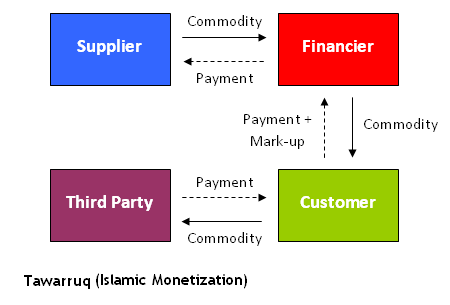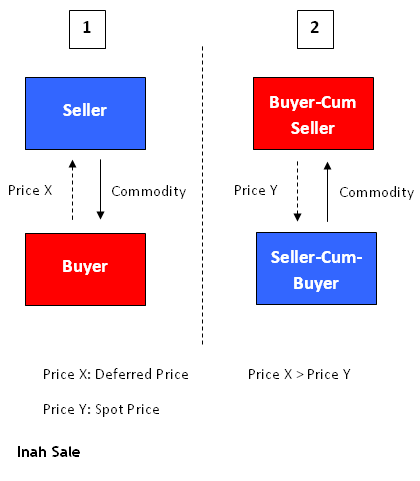Both tawarruq and inah are two different developments of murabaha. Tawarruq is sometimes called commodity murabaha as it involves having access to cash through the trading of a commodity in a real transaction. Tawarruq refers to the purchase and sale of a commodity wherein three different parties are involved: a buyer and seller in the first leg of the transaction and a seller (the original buyer) and a buyer (third party) in the second leg. The following diagram presents a simple structure of tawarruq:

Tawarruq is permitted by shari’a insofar as it is used as a last resort in pursuit of liquidity. Hence shari’a doesn’t promote the use of tawarruq munazzam (pre-arranged monetization) by Islamic banks and financial institutions. This form of tawarruq reflects the use of the murabaha contract for pure credit transactions and is forthrightly rebuked by Islamic jurists and scholars (at least in the Arabian region).
On the other hand, inah (repurchase by the seller) is a replication of a conventional loan (interest-based lending and borrowing). Bay’ al-inah is the sale of the same commodity between the same two counterparties (sale and buy-back) at different prices in proportional consideration to the period of credit (repayment). In practice, one party buys a commodity (e.g., copper, iron, and so on) from another on credit (bay’ muajjal) and sells it back to that very party on spot for immediate cash (a lower amount of cash), with the difference being the cost of financing (interest payment on the implicit loan):
Inah interest = repayment amount – immediate cash
This interest or riba (implicitly charged by one party and paid by the other) renders this type of sale outspokenly invalid and prohibited as the underlying commodity is fictitiously exchanged between the parties with no intention to possess it by the buyer. Below is a depiction of the process of inah sale:




Comments